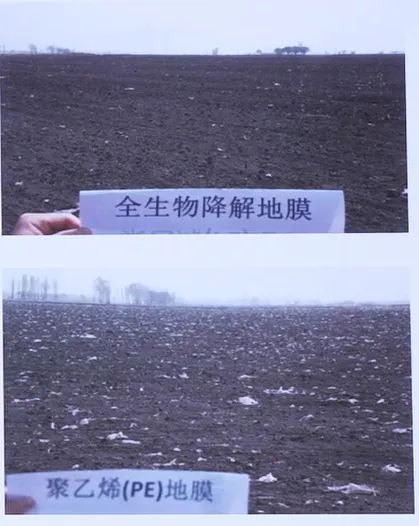 73
73
According to the Institute of Biodegradable Materials, the average residual amount of plastic film in Xinjiang is as high as 13.8 kg/ mu, much higher than the national average of 3.45kg/ mu. Recently, Professor Lu Jun of the Western Agricultural Research Center of the Chinese Academy of Agricultural Sciences revealed this shocking data, and the severe pollution situation has prompted relevant practitioners to seek effective solutions to the problem of residual film pollution.
On November 28, the "Green Energy Chemical New Material Industry Innovation Chain Development Conference" was held. At the meeting, Professor Lu Jun of the Western Agricultural Research Center of the Chinese Academy of Agricultural Sciences delivered a keynote speech on the adaptability evaluation and Application Prospect prediction of fully biodegradable mulching film in Xinjiang Region.
In his speech, Professor Lu Jun of the Western Agricultural Research Center of the Chinese Academy of Agricultural Sciences systematically explained a series of key issues such as why biodegradable mulch film is needed, whether biodegradable mulch film can be completely degraded, the feasibility of the practical application of biodegradable mulch film, and the opportunities and challenges faced by the promotion process of biodegradable mulch film. The application and development of biodegradable mulching film in Xinjiang agricultural field were thoroughly analyzed for participants.
The following is a summary of the speech:
1. Why do we need biodegradable mulch
In Xinjiang agricultural production, mulching technology occupies a very important position. It has significant functions such as increasing temperature, conserving soil moisture, controlling grass and increasing yield, so as to move the planting boundary northward, improve water use efficiency and crop yield, and widely cover a variety of cash crops and bulk food crops. However, with the continuous use of mulch, the problem of residual pollution of farmland mulch is becoming more and more serious, and there are different degrees of pollution in the country's mulch areas, with an average of 3.45kg/ mu, and Xinjiang is the most serious, with an average of 13.8kg/mu. In this context, full biodegradable mulching film has become a key direction to solve residual film pollution.
2, biodegradable plastic film can be completely degraded
PBAT fully biodegradable film can be completely degraded within 3 years, through the synergistic action of a variety of bacteria and fungi, and finally mineralized into CO₂. The degradation process is affected by soil, climate and crops, and although microplastics are produced, they will eventually degrade completely. There is a risk of residual pollution in oxidized biodegradable mulch film.

 Continuous mulching of PE film and biodegradable mulching film for 5 years in farmland. (Shihezi General Factory, Xinjiang)
Continuous mulching of PE film and biodegradable mulching film for 5 years in farmland. (Shihezi General Factory, Xinjiang)
3, biodegradable film can not be used, however, compared with ordinary PE film, the function of degradable film needs to be improved, there are regional and crop suitability problems, the promotion and use of supporting agronomic measures, root crops are relatively more suitable. At present, production risks can be reduced through identification, reasonable selection of thickness functional period color, and matching agricultural cultivation technology, etc., and efficiency results have been shown on crops such as cool and tuber, which can cover the cost, and agricultural machinery supporting technology under cultivation mode is also being explored. 4. The opportunities and challenges faced by biodegradable mulch film The current situation of pollution has prompted active governance in the agricultural field, and increased production and efficiency has become a driving force for promotion. On the one hand, it is necessary to prohibit the use of dual-degradation (that is, photooxygen degradation) material mulching film, and gradually promote the use of short-functional efficiency crops such as cool crops and tuber crops. On the other hand, it is necessary to continue to study ultra-thin biodegradable film to reduce costs, explore improvements in raw materials and material properties, and strengthen scientific and technological training. Relevant government departments should also provide support and guarantee from various aspects such as policy, finance, law, media publicity, and science and technology promotion, so as to promote the continuous and stable promotion of biodegradable mulching film, and realize the win-win situation of green and sustainable agricultural development and pollution control in Xinjiang.
Fortunately, the newly revised Regulations on the Management of Farmland mulching Film in Xinjiang Uygur Autonomous Region have been implemented on May 1, 2024. This version is revised on the 2016 version, and encourage production enterprises to produce farmland mulch in line with the autonomous region's standards, and carry out scientific and technological innovation, the use of new technologies, new materials research and development, production of fully biodegradable farmland mulch; Encourage sales enterprises and farmland mulch users to sell and use farmland mulch that meets the autonomous region's standards and is fully biodegradable; Encourage research and development, promotion of waste farmland mulch recycling advanced technology and machinery, carry out waste farmland mulch reuse.


